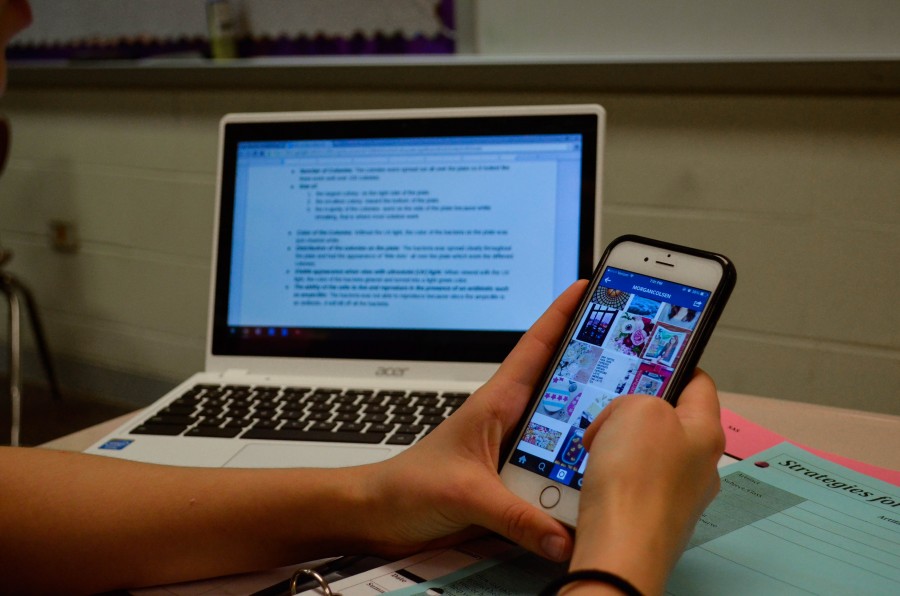As DGN marches towards 1:1, questions have arisen about whether the school’s infrastructure can handle the increase in Wi-Fi usage.
“The Wi-Fi connection at school is too slow most of the time for me to actually look anything up,” senior Molly Michaels said. “I’m sure next year, when everyone has a Chromebook, the connection will be much worse.”
According to an Omega survey, 68 percent of the 397 student responders experience connectivity issues two or more times a week while on a Chromebook, laptop, or desktop computer.
Students, like junior Natalie Costello, are worried about what will happen with the wireless connection next year when every student has a Chromebook to use. “There have been problems with the Wi-Fi the entirety of the time I’ve been in high school. I think next year is going to be a nightmare,” Costello said.
Many other students have shown concern about what will happen when the school goes 1:1. “For the amount of devices using internet here at school, we should definitely have a better Wi-Fi connection. Especially considering the fact that next year the entire school will have Chromebooks,” an anonymous participant responded to the survey.
Another student responded with, “It isn’t as strong as it should be considering they want to move us into an even more technology-filled atmosphere. For the number of students that want to use it, the connection is just so poor.”
Among other responses were, “I wish the Wi-Fi signal could be stronger considering that we are going 1:1 next year,” and, “If everyone has a Chromebook next year, I’m positive that it would be imperative to upgrade the school Wi-Fi.”
However, members involved in the decision to switch to 1:1 technology made sure the Wi-Fi strength wouldn’t be a problem. According to Principal Scott Kasik, when the building went wireless in 2011, one node was placed in each classroom that can handle 30-35 devices, depending on the bandwidth.
Dr. Ken Sorensen is Associate Principal for operations and technology at DGN. “My role as associate principal is to oversee technology at DGN. We’ve [district technology team] been working for multiple years with this in mind,” said Sorensen. “It [the wireless infrastructure] should be able to handle a classroom full of Chromebooks. We have a filter that we can throttle depending on how the bandwidth is being used and for what purposes.”
Common areas like the lunchroom where students could be using their phone and Chromebook may have issues with internet access. “There might be areas where we have to put in more access points just to cover common areas,” Sorensen said.
“The building, we believe, will be able to handle the increased use. When we were doing the wiring for this building, we were planning ahead knowing we’d probably get to this point,” Kasik said. “Now that we know we can handle the bandwidth, if there are areas in our building that are experiencing difficulties [when we go to 1:1], we will address those areas to make sure everyone’s computer has access to the internet.”
The same survey reported that 68 percent of students connect their phone to DGN’s Wi-Fi network. If over half the student body has their phone connected to the internet, and 25 percent of students use a Chromebook every day, nodes in each classroom may get overwhelmed.
Director of Technology and Information Services Rod Russeau also believes DGN is capable of handling the new technology due to tests performed this past summer. “We had an outside networking company perform an assessment of our network infrastructure this past summer. District 99’s technology score was very high, in the 95th percentile,” Russeau said. “The network activity monitoring portion of the assessment did detect a few bottlenecks in our wireless network, but we made many changes this past summer to address those performance issues.”
The solution to what seems like such a big issue should be simple: to disconnect cell phones from the school Wi-Fi while in a classroom where Chromebooks or laptops are being used. “It might become standard practice for teachers to tell their students to disconnect from the Wi-Fi on their phone while using Chromebooks,” Sorensen said.
However, that may not be as easy as it seems. “Even if teachers told me to disconnect my phone each time, I don’t think I would,” Costello said. “I don’t think a lot of other students would either. Kids don’t just use their phone for texting.”
“I use my phone to connect to the Wi-Fi and listen to music and check e-mail during school. I wouldn’t disconnect it every day,” senior Anthony Civito said.
“The network activity monitoring portion of the assessment did detect a few bottlenecks in our wireless network,” Russeau said. “We made many changes this past summer to address those performance issues. There remain occasional reports of network slowness and bottlenecks occurring during the pilot, but we continue to closely monitor any issues and make adjustments accordingly.”
Mia Chudzik | Feature Editor
[email protected]



